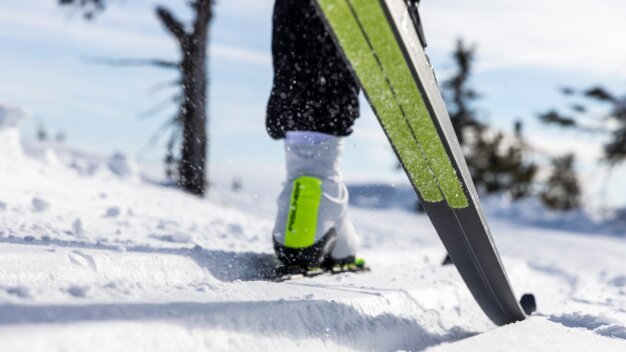
When it comes to cross-country skiing, regular waxing is the key to a constantly great performance. By caring properly for your skis, you ensure many kilometres of smooth gliding across the best cross-country ski trails.
But how do you wax your cross-country skis properly? We have a few great tips for you which make it easy for you to wax your cross-country skis at home.
Some good reasons why you should regularly wax your cross-country skis
A long lifespan and excellent gliding properties: These are the two main benefits you get from regular waxing. By waxing, you ensure that the pores of your ski base stay functional. If they are damaged, water can soak into the base of your skis, and the gliding properties decrease – and you get more friction between the base and the snow.
However, this can easily be prevented by applying water-repellent wax to your skis. This causes the pores to become water-resistant, and gliding properties remain excellent.
How often should you wax your cross-country skis?
How often you should wax your cross-country skis depends on the snow you’ll be using them in. What’s more, it’s also a question of how often you go cross-country skiing. Professional skiers who need excellent gliding properties at all times tend to wax their skis daily.
If you’re a leisure skier, waxing your skis every two to three days is usually enough. If you notice white spots on the base of your cross-country skis, it’s time for a waxing session.
For some extra love and care, treat your cross-country skis to some additional wax spray, which helps to remove dirt from the pores of the ski base.
Which wax is best?
There are different types of waxes, which vary in their hardness. Choose the hardness that best corresponds to the type of terrain you usually ski on. For older snow on the trails, use a soft wax. For cross-country skiing on very cold or fresh snow, we recommend using a hard wax.
Plus, there are more differences:
Hot vs. cold wax
To apply hot wax, you need an iron. By heating the wax, it can enter the pores of the ski base, sealing the entire surface. Cold wax, on the other hand, is applied directly, without any prior treatment. This makes cold wax a bit easier to use. On the downside, you have to apply it more often than hot wax.
Kick vs. glide wax
Some waxes come with special properties. For instance, kick wax is very hard, giving it additional grip in the snow. Glide wax is available for hot or cold waxing, with both of them offering particularly good gliding properties.
For our planet: Go for a wax that’s biodegradable and fluoro-free!
A practical guide to waxing your cross-country skis
Before waxing your skis, you need to determine which type of cross-country skis you have. There are skis with and without scales.
- Cross-country skis without scales: Depending on the model, they have different zones. Treat the glide zones with regular wax and the kick zone (as found in classic cross-country skis) with a special wax!
- Cross-country skis with scales: For skis with scales, no wax is applied to the kick zone. Instead, liquid wax spray is used. For the gliding zones, use normal wax.
Now you can start with the actual waxing:
Step 1: Clean the base
Depending on how much dirt there is on your cross-country skis, you might have to clean them first. To do so, use a brass brush or, for more stubborn dirt, a base cleaner. For thorough cleaning, apply the cleaning agent first, wipe it off with a cloth and remove any remaining dirt with the brush.
Important note: Always brush from the tip of the ski towards the tail!
Alternatively, you can also apply a layer of hot wax and then remove it while it’s still warm! This also helps to remove dirt.
Step 2: Apply the wax
Depending on the type of wax you use, apply it cold directly onto the skis or use an iron to heat it up. If you use hot wax, make sure not to exceed the maximum temperature of 140 degrees Celsius – if there’s smoke, it’s too hot! If your iron has special settings for wool or silk, it’s best to use those.
Make sure to apply the wax evenly and allow at least ten minutes (or, ideally, half an hour) for it to cool.
Step 3: Remove excess wax
After the cooling phase, start by clearing the groove in the coating of any excess wax using a pencil groove scraper. In a next step, remove wax residues from the base with a scraper, starting from the ski tip working downward. Be gentle to avoid any potential damage.
Use a brass brush to remove any remaining wax, with strokes running from the top to the tail of the ski. For a shiny finish, you can use a nylon brush.
Is there a difference between waxing classic cross-country skis and skate skis?
The waxing procedure is the same for both types of skis. However, the base of classic cross-country skis has two glide zones – one in the front and one in the back, with the climb zone in the middle.
When waxing classic cross-country skis with scales, make sure not to apply any wax to the climb zones.
Finished waxing? Hit the trails!
Once you have waxed your cross-country skis, it’s time to hit the cross-country trails. If you’d rather put the waxing of your skis in more experienced hands, don’t hesitate to rope in the experts – for instance at an INTERSPORT Rent shop near you.
INTERSPORT Rent tip
You don’t have cross-country skis? Make use of the great offers of INTERSPORT Rent and rent your equipment at one of our many locations!







